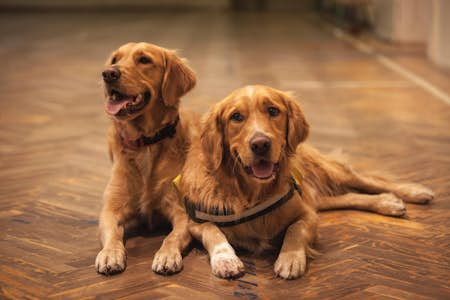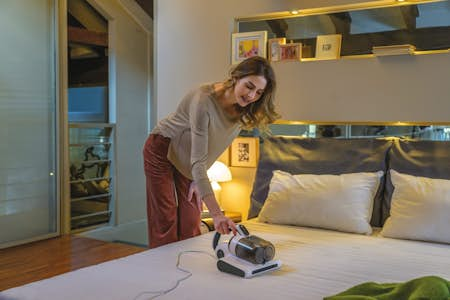Dog owners will usually have to face this question sooner or later. No matter how inviolable you may consider your pooched-up partnership, there will at some point arise a situation in which you and your furry friend have to part ways for a short while.
So, dogs are having to face a life with their fair share of Macauley Culkin. That’s right: home alone. We’ll see how much you can fairly inflict on a dog. We’ll look at some tips you can use to assist. We’ll also see what might be the best breeds of dog to consider getting.
Whether you're looking for a tailored diet solution for your furry friend or are looking for better value from your pet food shopping, our providers have various options to help meet your needs. Click a brand below to discover more of what they offer!
So, is it cruel?
Let’s deal with this, the mastiff in the room. Dogs are fundamentally social animals, never happier than when raising a ruffing great rumpus with other dogs or just hanging out with the family. So it would seem on first inspection that to inflict solitude on a dog is anathema to their nature, hence really rather unkind. Consequently, leaving them alone all day, in the majority of cases, is not really on.
However, dogs exist in the real world. OK, their philosophical acumen may be slightly limited (although they do like a bit of Karl Barx). But they can deal with a great many of the things that life can throw at them. They’re nothing if not adaptable - this is one of the secrets of their success thus far in the great evolutionary saga.
What’s the maximum time you can leave a dog home alone?
So, this is the 64,000-dollar dog care question. While it will depend a great deal on the individual dog and circumstances, such as the environment you’re leaving the dog in, the limit that’s recommended by the RSPCA is four hours. This is for adult dogs. You can pair this up with various techniques to enable you to combine dog ownership with a 9-5 job.
What does the law say?
Not much. There’s no legal limit on the time you can leave a dog alone, per se. However, under the Animal Welfare Act, owners are responsible for their pets’ wellbeing. So, if they’re suffering because of being left alone, then the owner can be prosecuted.
If you have a new dog, even if they are super-calm, don’t assume that they’ll be OK to be left for long periods of time alone straightaway. Dogs are like us - they like to get settled before they feel at ease. Give them time to acclimatise and feel secure in their new place.
You can then build up their acceptance of being alone by introducing the idea and boosting it gradually until things are happily embedded in the canine cranium.
Also bear in mind that older dogs are better at the whole alone thing than younger dogs, so, if you’re at the stage of wondering about what kind of dog to get, it might be a good idea to consider a senior dog.
Puppies
Don’t leave a very young puppy alone at all - they’re only recently separated from the constant reassuring socialisation presence of their mother and litter mates. Failure to handle their first time alone properly can lead to an aversion to being left alone at all in later life. So, gently does it, and build up slowly.
Puppies under six months old should only be left alone for short periods - no more than two hours. Quite apart from anything else, their bladders won’t be mature yet, so you’ll be playing fast and loose with that carpet of yours.
What tips can you deploy to make things easier?
Crate expectations
A lot of pet owners don’t get the idea with crates. Why would a dog want to be shut for any length of time in a locked kennel? Yes, to the uncanine mind, it does seem cruel, or at least not ideal. But, to a dog who’s used to a crate, it represents safety and security.
The lesson here is that if your dog comes to you already crate-trained, welcome this state of affairs with open arms. You’ve got there one of the best elements of training you can possibly have. Not only do crate-trained dogs like their bolt hole, but it also keeps them safe from hazards around the home, and it keeps your home safe from hazards from your dog.
So, don’t be quick to discount crates. But don’t just whack an untrained dog in one and expect them to be happy in there. This will lead to disaster, and is inordinately cruel. Crate training is worth it, but it takes a long time and can be tricky to pull off.
On the point of training, we spoke to Nicky Spanswick from Gloucester Animal Welfare Association & Cheltenham Animal Shelter, who told us: "Persistence and patience are key when it comes to training. When looking for expert advice, we would highly recommend using a qualified behaviourist who only uses force free, positive training methods and techniques. Positive training focuses on building your dog’s confidence, making them more resilient when faced with challenging situations. It is also great for building the bond between you and your dog!"
Walk it off
It shouldn’t come as a surprise to anybody that dogs need exercise. But it’s not just for general wellbeing. Take your dog for a good old walk, and you’ll take the edge off their energy levels, which means they’ll be more amenable to the idea of chilling out for a while. It’ll also mean that any bathroom break requirements have been well and truly attended to.
A dog with stacks of get-up-and-go still in place when you leave them will be more likely to inflict their energy on something yielding to a satisfying bit of chewing, like a chair leg or that old fave, a favourite shoe. So, wear them out and leave them tired but happy.
Make it positive
Canines pick up on moods, so lighten up and make your departure as upbeat as you can. You don’t need to trot through the house, gleefully waving and singing goodbye, but you can try distributing some treats around the place as you go. This engages a dog’s foraging side and promotes positive associations. With a little fun injected into the mix, you can make alone time much more enjoyable.
Some dogs can be trusted with chew toys when alone. But beware - if yours is a dog that likes to tear things to shreds then choke on the results, then this won’t be an ideal situation to encourage. Mind you, there are some fun and tough options (like a Kong stuffed with peanut butter, for instance) that might be worth looking at.
Keep the positivity going when you return, even if you come back to find that hell has been unleashed on your house. Your dog won’t link your remonstration with any wrongdoing - they’ll just think you’re being cross out of the blue. Result? Greater anxiety while they’re alone, worrying about what kind of mood you’ll be in when you return. So, stay buoyant, and think about how you can prevent the damage from happening next time.
Are there any breeds that are better left alone than others?
Dogs vary from individual to individual, but there are breeds that seem to do better alone. These include Labradors and Golden Retrievers, due mainly to their confident personalities and generally happy-go-lucky natures.
Other breeds include sight hounds, in other words, greyhounds, whippets and lurchers. This is because they tend to be all-or-nothing dogs - flat out in a field or flat out on a sofa. Get them worn out with a quick burst of speed then park them somewhere cosy.
Generally speaking, you should avoid the more highly-strung breeds of dogs. These are the ones that tend to be a little more neurotic. So, step forward German Shepherds and Bichon Frises.
It’s often true that the brighter the dog, the more prone they are to separation anxiety. This can be particularly true of Border Collies, the Mensa-standard dog breed. For these chaps, a puzzle toy is often a great idea. Or a challenging Sudoku.
Basset hounds and hounds, in general, are a good choice. They’ve been bred to rely on themselves - after all, when facing some large quarry they may be cut off from their hunting master, so often have to decide for themselves there and then what the best course of action is.
Personal experience bears this out. An old Rhodesian Ridgeback of mine was happy alone for hours on end, snoozing away and dreaming of lion-bothering out on the veldt. My current poodle-Jack Russell cross? Not so much. Five minutes alone and the howling starts.
Can dogs dig it?
Yes they can! You can make separation perfectly OK for most dogs. It’s all about how you prepare for it. Dogs love routine, so it’s generally the case that the more you do a thing, the easier it gets. So, don’t lose heart if it doesn’t work out straight away.
If your dog’s a die-hard company-lover, you can always consider looking into doggy daycare. Or, if you know a reliable and trustworthy dog walker, they can break up some alone time with a well-timed walk. You can even try a tech solution, with a pet camera linking you and your dog for electronic check-ins through the day.
Finally, should the situation demand it, you may find that it pays to spend an amount of time with a behaviourist. So, even if you’re struggling to deal with the most destructive behaviours, don’t give up. Help is at hand. And at paw.
Image Credit: Dominika Roseclay at Pexels









